TRPM8 mechanism of cold allodynia after chronic nerve injury
- PMID: 18077679
- PMCID: PMC6673615
- DOI: 10.1523/JNEUROSCI.2203-07.2007
TRPM8 mechanism of cold allodynia after chronic nerve injury
Abstract
The cold- and menthol-sensitive receptor TRPM8 (transient receptor potential melastatin 8) has been suggested to play a role in cold allodynia, an intractable pain seen clinically. We studied how TRPM8 is involved in cold allodynia using rats with chronic constrictive nerve injury (CCI), a neuropathic pain model manifesting cold allodynia in hindlimbs. We found that cold allodynic response in the CCI animals was significantly attenuated by capsazepine, a blocker for both TRPM8 and TRPV1 (transient receptor potential vanilloid 1) receptors, but not by the selective TRPV1 antagonist I-RTX (5-iodoresiniferatoxin). In L5 dorsal root ganglion (DRG) sections of the CCI rats, immunostaining showed an increase in the percentage of TRPM8-immunoreactive neurons when compared with the sham group. Using the Ca2+-imaging technique and neurons acutely dissociated from the L5 DRGs, we found that CCI resulted in a significant increase in the percentage of menthol- and cold-sensitive neurons and also a substantial enhancement in the responsiveness of these neurons to both menthol and innocuous cold. These changes occurred in capsaicin-sensitive neurons, a subpopulation of nociceptive-like neurons. Using patch-clamp recordings, we found that membrane currents evoked by both menthol and innocuous cold were significantly enhanced in the CCI group compared with the sham group. By retrograde labeling afferent neurons that target hindlimb skin, we showed that the skin neurons expressed TRPM8 receptors, that the percentage of menthol-sensitive/cold-sensitive/capsaicin-sensitive neurons increased, and that the menthol- and cold-evoked responses were significantly enhanced in capsaicin-sensitive neurons after CCI. Together, the gain of TRPM8-mediated cold sensitivity on nociceptive afferent neurons provides a mechanism of cold allodynia.
Figures

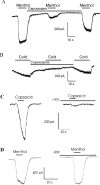
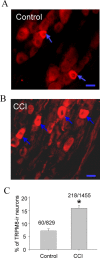
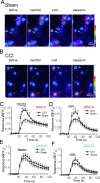

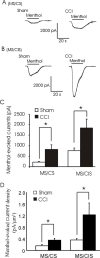
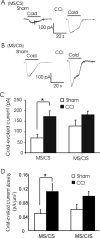
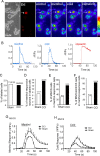
Similar articles
-
Role of TRPM8 in dorsal root ganglion in nerve injury-induced chronic pain.BMC Neurosci. 2011 Nov 23;12:120. doi: 10.1186/1471-2202-12-120. BMC Neurosci. 2011. PMID: 22111979 Free PMC article.
-
Operant behavioral responses to orofacial cold stimuli in rats with chronic constrictive trigeminal nerve injury: effects of menthol and capsazepine.Mol Pain. 2013 Jun 14;9:28. doi: 10.1186/1744-8069-9-28. Mol Pain. 2013. PMID: 23767981 Free PMC article.
-
Downregulations of TRPM8 expression and membrane trafficking in dorsal root ganglion mediate the attenuation of cold hyperalgesia in CCI rats induced by GFRα3 knockdown.Brain Res Bull. 2017 Oct;135:8-24. doi: 10.1016/j.brainresbull.2017.08.002. Epub 2017 Sep 1. Brain Res Bull. 2017. PMID: 28867384
-
The TRPM8 channel as a potential therapeutic target for bladder hypersensitive disorders.J Smooth Muscle Res. 2022;58(0):11-21. doi: 10.1540/jsmr.58.11. J Smooth Muscle Res. 2022. PMID: 35354708 Free PMC article. Review.
-
Current View of Ligand and Lipid Recognition by the Menthol Receptor TRPM8.Trends Biochem Sci. 2020 Sep;45(9):806-819. doi: 10.1016/j.tibs.2020.05.008. Epub 2020 Jun 9. Trends Biochem Sci. 2020. PMID: 32532587 Free PMC article. Review.
Cited by
-
Evaluation by Survival Analysis of Cold Pain Tolerance in Patients with Fibromyalgia and Opioid Use.J Pain Res. 2022 Sep 9;15:2783-2799. doi: 10.2147/JPR.S368805. eCollection 2022. J Pain Res. 2022. PMID: 36111289 Free PMC article.
-
Gαq Sensitizes TRPM8 to Inhibition by PI(4,5)P2 Depletion upon Receptor Activation.J Neurosci. 2019 Jul 31;39(31):6067-6080. doi: 10.1523/JNEUROSCI.2304-18.2019. Epub 2019 May 24. J Neurosci. 2019. PMID: 31127000 Free PMC article.
-
Molecular and cellular limits to somatosensory specificity.Mol Pain. 2008 Apr 18;4:14. doi: 10.1186/1744-8069-4-14. Mol Pain. 2008. PMID: 18419827 Free PMC article. Review.
-
Converting cold into pain.Exp Brain Res. 2009 Jun;196(1):13-30. doi: 10.1007/s00221-009-1797-2. Epub 2009 Apr 28. Exp Brain Res. 2009. PMID: 19399484 Review.
-
Mammalian cold TRP channels: impact on thermoregulation and energy homeostasis.Pflugers Arch. 2018 May;470(5):761-777. doi: 10.1007/s00424-018-2145-9. Epub 2018 Apr 26. Pflugers Arch. 2018. PMID: 29700598 Review.
References
-
- Abe J, Hosokawa H, Okazawa M, Kandachi M, Sawada Y, Yamanaka K, Matsumura K, Kobayashi S. TRPM8 protein localization in trigeminal ganglion and taste papillae. Brain Res Mol Brain Res. 2005;136:91–98. - PubMed
-
- Abe J, Hosokawa H, Sawada Y, Matsumura K, Kobayashi S. Ca(2+)-dependent PKC activation mediates menthol-induced desensitization of transient receptor potential M8. Neurosci Lett. 2006;397:140–144. - PubMed
-
- Babes A, Zorzon D, Reid G. Two populations of cold-sensitive neurons in rat dorsal root ganglia and their modulation by nerve growth factor. Eur J Neurosci. 2004;20:2276–2282. - PubMed
MeSH terms
Substances
LinkOut - more resources
Full Text Sources
Other Literature Sources
Miscellaneous
